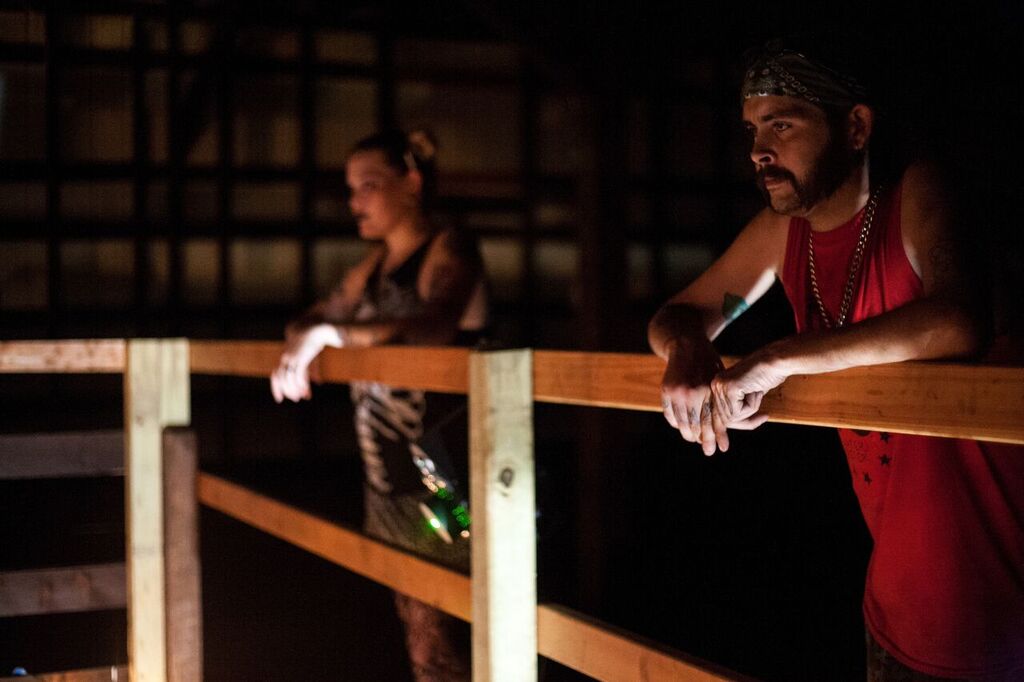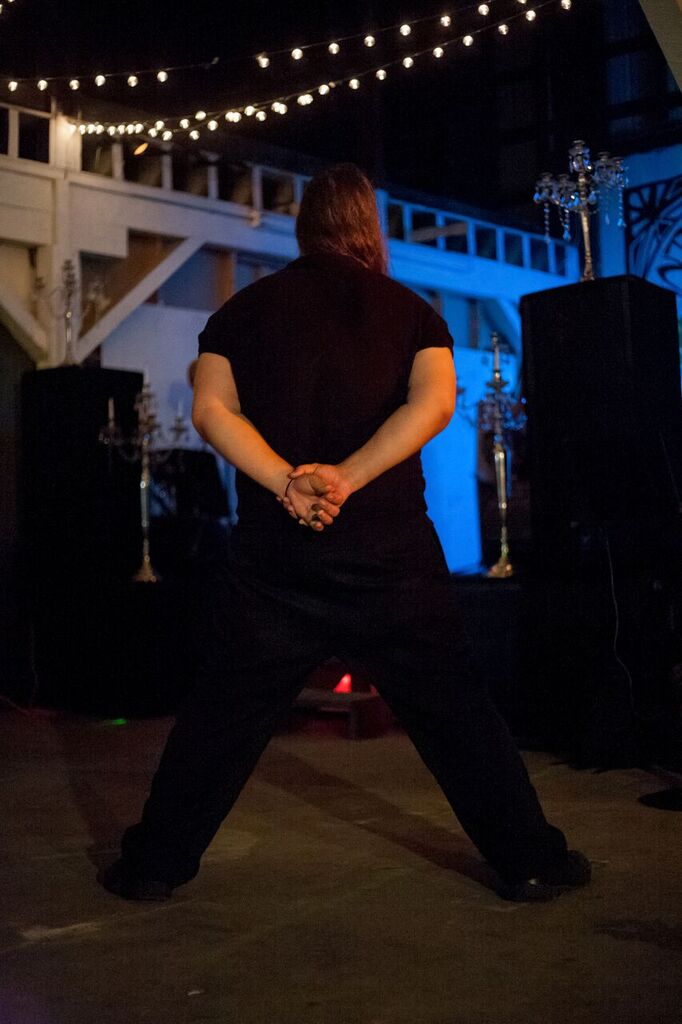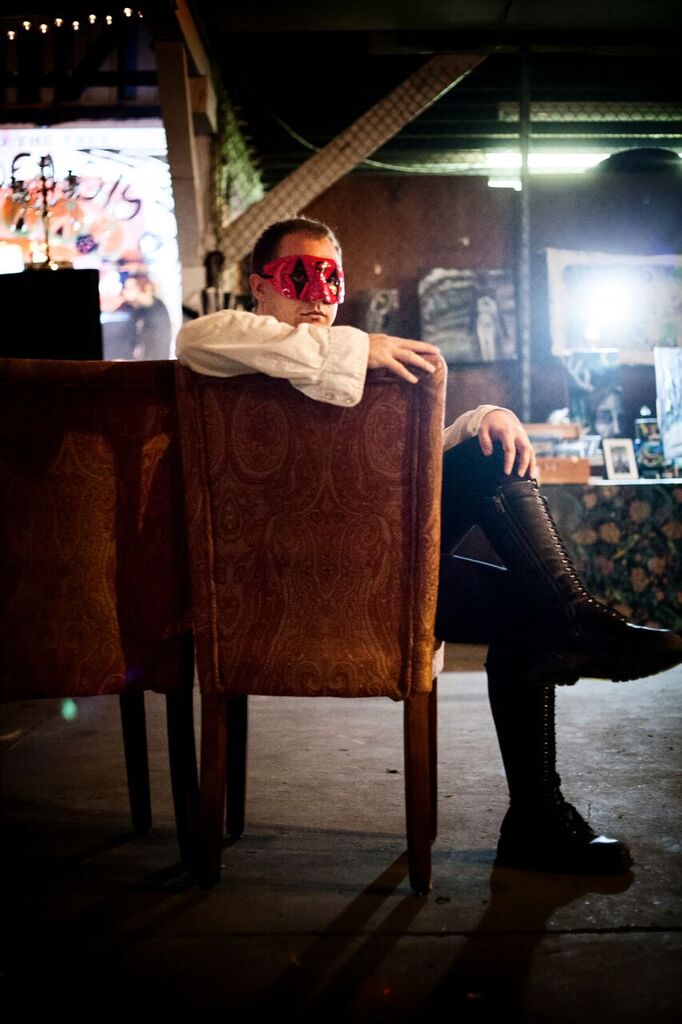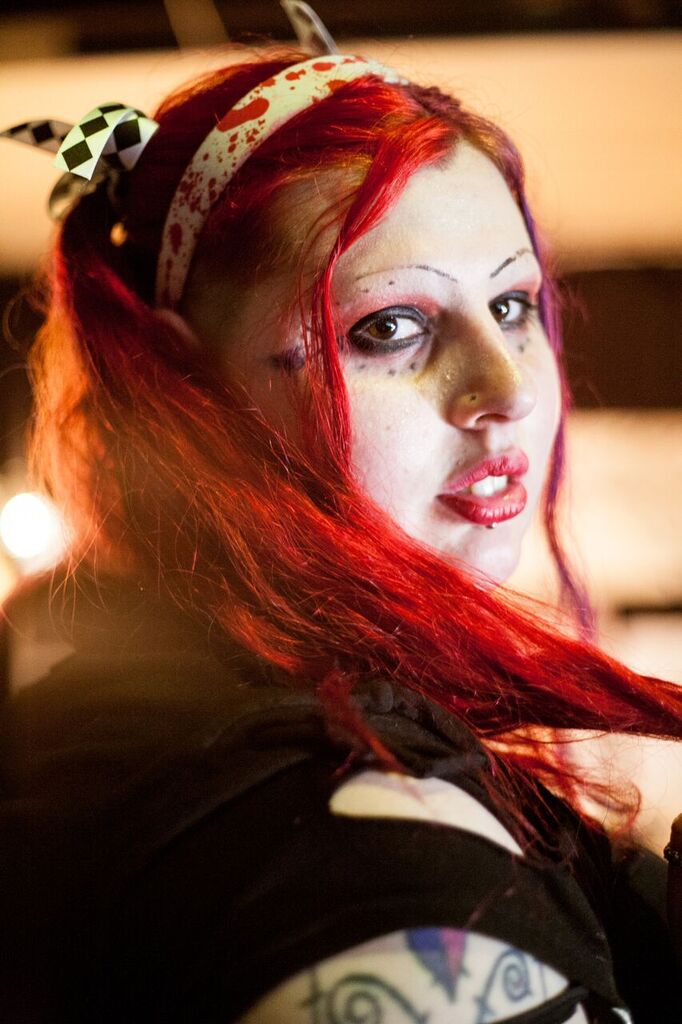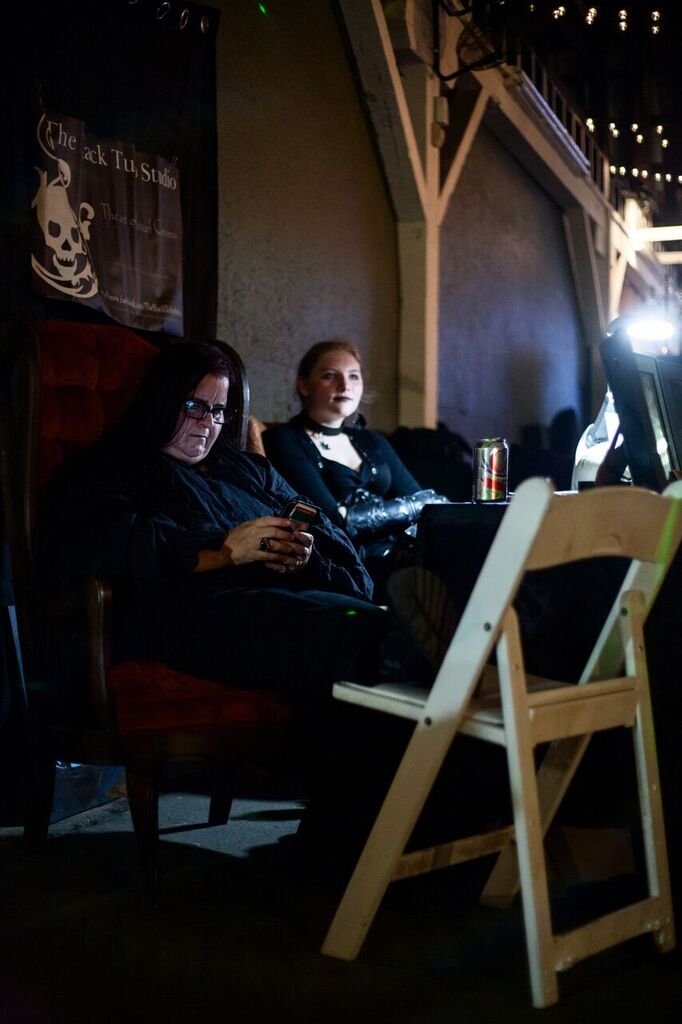About fifteen people sit around plastic tables in the warehouse’s gravel parking lot, making small talk while staring at their phones, the blue electronic glow reflecting off pleather corsets and platform boots. A ten-foot wide psychedelic demon face gapes at us above the warehouse entrance, a junior high notebook scribble made real. The thump-thump-thump of the speaker system issues out of its maw like hellish indigestion.
“I’m going through a divorce, I just moved into this tiny new place with my cat,” Valek Reed says. He turns to me, balls his fists, and paws at my chest, meowing. A silver ring wraps around the middle of his bottom lip. “She’s in fucking heat all the time. It sucks, man. But we’re here. We’re here. Check it.”
Videos by VICE
He crouches, unseen leather accessories creaking as he bends, and frames the belching demon billboard with his hands as if snapping runway photos. A couple people at the tables glance over at us.
“There it is. There’s your fucking shot. You’re witnessing the death of the New Orleans goth scene.”
This weekend marks the seventh Southern Gothic Festival hosted in the Crescent City, and by most accounts, it will be its last. The town owes its mystique to the likes of Voodoo priestess Marie Laveau and the innumerable spirits haunting lantern-lit steamy French Quarter avenues; this is where Anne Rice put her ink blot on the map with her literary harem of lithe-bodied vampires and their devoted fans. It’s the mecca of goth living—and dying – so the sparse scene around us is somewhat difficult to comprehend.

Val leads me into the warehouse—opened recently as an art market and venue space called the Avant Garden District—and as a couple volunteers run cables across the venue stage, he gives me a crash course in the rise and fall of the American goth scene, particularly here in New Orleans. He shakes hands with a couple of visitors, and rapidly argues that, even though LA and New York City had sizeable subcultures of their own, they were still constricted by the larger population. He then disappears as quickly as he showed up, excusing himself to check on the musician lineup.
“New Orleans didn’t need goth clubs. It was a goth club,” he would clarify for me in an email the next week, apologizing for an unfortunate festival cocktail of booze, illness, stress, and lack of food. “…being a city if [sic] freaks, fuck-ups, and eccentrics, [we didn’t] have any natural predators.”
Two weeks before Hurricane Katrina, a Canadian expat known as Leslie Frankenstein moved to the city, weathered the storm, and dedicated herself to continuing the community after the New Orleans’ mass exodus of denizens. Because bars were so desperate for business, Leslie was able to easily book goth and industrial dance nights throughout the week. “I could get a goth night at a sports bar if I didn’t have any dignity,” Val remembers.
The scene briefly rose again, culminating in the first Southern Gothic Festival in 2010, which featured local and national bands, art, and events. As New Orleans got back on its feet, however, those original venues didn’t need specialized nights to attract customers anymore, and those that did imposed steeper bar prices and door covers. One of the final blows came a couple years back when Leslie Frankenstein suddenly died of a brain aneurism in her sleep. According to Val, the remaining goth kids simply grew up, moved away, or gave up entirely. “Outnumbered by dubstep,” he rues.
I clamor over the elevated band platform, and make my way behind towards the backstage. Standing in the doorway to the greenroom are Liz Morrison and Gary Zon of Lizvfer and the Tree. Gary’s respected goth band, Dismantled, played here in years’ past, and going off those memories, the duo chose to travel from Los Angeles to play SoGo for their first show. Both of them wouldn’t have it any other way – to them, there was no question about the location.

“To play in LA would be the worst thing we could do for ourselves,” says Zon, “because it’s such a bad scene out there. It’s all pay to play, it’s all shitty venues and this and that.”
“I love how dark it is [in New Orleans]. No one fights against the elements. Everyone sort of accepts things for the way they are,” adds Liz.
Zon tells me he first played here well before Hurricane Katrina, and even then, the city spoke to him and his bandmates.
“Every time we’d play here our keyboardist would say, ‘I’m haunted. Something is wrong with me.’ Or some shit like that.”
Before taking the stage, Liz and Zon take a moment to tell me how much they love working together. The collaborative effort stems from their clash of cultures – Zon is a diehard goth devotee, while Liz views it more of her alter-ego. By day, she works with the LA mayor’s office advocating for sustainable energy solutions. Zon admires that duality.
“I feel like if the end of the world happens, she’ll be the most likely to kill both of us.”
Liz nods.
“I’m small, I’m fast, and I don’t have a problem with killing,” she says, laughing as she offers me a half pint of Jose Cuervo.
Their first set as a pair goes off without a hitch. Lizvfer and the Tree play sexed-out honky tonk covers, reconfigured with drum machines, humming synths, and enough distortion to make you forget the songs’ origins. Liz herself fully embraces her new role, even with only a handful of onlookers, writhing to the music under sinister blood-red stage lights.

“It’s like Yeah Yeah Yeahs at 33 speed instead of 45,” the co-owner of the venue, Josh Wiggins, shouts in my ear, a surprisingly accurate description.
“Thank you guys so fucking much,” Zon says as they finish their encore.
Three members of Infekt are lounging on a couch in the greenroom when I return after Lizvfer and the Tree’s show. The two smaller bandmates bookend their lead singer, who introduces himself as Loki. He looks like every “alt” musician stereotype rolled into one heavily tattooed package– shoulder-length hair the color and sheen of dirtied obsidian, black leather and chains strapped across a sinewy, six-foot-something frame – and smiles broadly while propping a shit-kicker boot atop the coffee table between us, a light cloud of cigarette ash briefly rising from a nearby bowl. There’s something instantly likeable in the trio, an inherent friendliness amidst the stretched ears and tattooed skin, and I find myself wanting to impress the kids who were once probably ostracized for these very attributes in high school.
Loki – incidentally, the brother of Val – explains that they travelled down here from Peoria, Illinois, to play, and that this was their second time performing at the Southern Gothic Festival. Only a couple days before he was working his 9-5, driving a forklift in a warehouse. Even he concedes that the scene has experienced better days.
“SoGo gave me a lot of hope. Now, even that seems…” he trails off, taking a sip from a tallboy. “Whether or not it’s gonna be here next year…I mean, I hope it is. We’d just love to see some kind of scene come back.”
The landscape isn’t much better back home. I ask if there happens to be a Peoria goth culture.
“It’s us three. Here we are,” says Bunny Bloodlust.
She laughs while pushing up a pair of white plastic frame glasses on her strategically shaved head. When not providing keys and assorted synth tones, Bunny works as a professional piercer and performance artist.

“When you’re playing, you don’t care about anything else. You’re just happy to be doing it,” explains Astoroth, Infekt’s guitarist as well as full-time hospital worker and part-time student. Loki remembers visiting New Orleans during the halcyon goth days of yore, even before SoGo existed.
“[Hurricane] Katrina is what I always tell people. Before that, it was amazing. Whether that was the cause or not, I don’t know, but that seems to be the moment,” he says. Two men walk into the green room, unassuming apart from their prerequisite all-black attire.
“Ah. Here are the two other members of Infekt,” says Loki, smiling again. Dave and Kryss introduce themselves. Unlike Loki, Bunny, and Astoroth, they’re lesser goth devotees.
“Symphonic metal,” Kryss says, nodding approvingly.
This is their first SoGo Fest, and, if the trajectory proves correct, perhaps their last. Still, like the rest of Infekt, their happy just to be among their own kind, in their own element, however small that may be.
As the band makes last minute preparations for the set, I head back out to the main area of the festival. The duo known as SINthetik Messiah from Lafayette, Louisiana – the geographically closest band to accept an invitation to play this year – are setting up laptops, a projector, and drum pads. A few attendees mill about the art vendors. One sits alone, sketching absentmindedly on an oversized drawing pad.
“This is my first time, but I’m familiar with the goth community,” says the artist, who goes by the monkier Iris. Donning fishnet arm stockings and a corset binding out of which peaks a flowery medieval blouse, Iris is 21 and grew up in Gretna, just across the Mississippi River from New Orleans on what is known as the Westbank. For Iris, this is one of the few times throughout the year she can be herself. “I’m into it, I can’t really do much of it around my family, but I’m really into it. My family is kinda uppity,” she says.
I ask about what she’s currently work on as deafening bass beats erupt from the PA system. SINthetik Messiah ushers the dozen or so people towards the stage.
“I do all kinds of art,” she shouts over the industrial drum loops. “Expressive art. There’s a lot of darkness in [it], because it comes from the soul.”

SINthetik Messiah summons a commendable amount of energy given the small scattering of people in front of them. Bug Gigabyte, the lead vocalist, howls through the electro-industrial set, never betraying a sense of disappointment at the near-empty room. Afterwards, he personally thanks each person for being there, going so far as to gift me a small flash drive containing all of his recorded material. Again, there’s the sense that these might be some of the nicest people in the Crescent City.
It’s cooled off, albeit only slightly, by the time I sit at an outdoor table with an unassuming Finnish couple named Janne and Katri from Finland. They’re completing their American road trip, which took them from New York City to here. The pair got off the train at 3:00 that very afternoon, ate dinner, looked up local events, and headed straight for SoGo. It’s more nostalgia than anything else at this point for them. Katri explains that, as a teenager, she first started going to goth clubs with her sister as soon as she turned eighteen, and began DJing shortly thereafter.
“Not so much these days, sadly. I should get back to it. We were kind of surprised to find a Southern Gothic Festival. It was kind of a beautiful thing, so we had to come here. We were pretty stoked.”
They both look around at the nearly vacant lot. Nearby, a man I would later learn is a prominent local vampire and ghost tour guide scrolls through his iPhone 6, tapping the screen with Nosferatu-like sharpened black fingernails. I ask Janne and Katri if they’re coming back the following night for the continued festivities, and they shake their head no while smiling.
“Unless you know something that we don’t,” Janne says.
The opening dissonant cacophony ushers in Infekt’s set. I go back inside once again to check them out, and watch Loki take the stage, backlit by strobe lights and clutching a severed mannequin’s head. Since we last spoke, Bunny has changed into form-fitting nun’s robes. The band launches into their songs, and I’m immediately reminded of early Marilyn Manson, before the acting career and the pontificating and the bloated belly. I mean this in a good way – like SINthetik Messiah before them, Infekt play as if this were one of the SoGo’s of yesteryear, when hundreds of people stopped by over the course of the weekend.

They’re completely at home here, and want me to enjoy it just as much as they clearly are. Just a few days before, I was at a crowded bar watching some popular local psych-rock band whose name I already forgot. They just stood there, too cool to be bothered to acknowledge anything around them. It was mind-numbingly bland, and I realize how many of those shows I’ve been to over the years—the same tired bands playing tired music for tired people. There’s a heart here at what’s left of SoGo, however blackened it may be.
As Loki attaches a dog collar to Bunny’s neck, she starts shimmying against him, ripping off her habit and veil to reveal lingerie as she begins to spit fake blood at the crowd. I take it as my cue to leave, but before doing, so talk with one more woman outside with Infekt’s music soundtracking our conversation. Like Iris, Josie is both an attendee and an art vendor, providing “lots of cute gothic stuff” for her customers. She speaks with a slight lisp through her tongue and lip piercings, her fuchsia-dyed hair practically glowing from the nearby street lights. She’s considered herself a part of the New Orleans goth scene for going on fifteen years now, watching the community get smaller and smaller.
“It was a better time. It felt like I found people I could actually associate with and they didn’t think I’m weird. It was a combination of people leaving, and jobs,” she says. Part of the reason she’s never abandoned the music or the aesthetics is because she wants to prove, like the fantasy characters she creates and illustrates, that the movement is eternal.
“I’m a single mom, and somehow I’m able to do it,” Josie says. “I have a feeling it’s gonna start picking back up. If we keep pushing it, it’s gonna speed back up. We just gotta keep doing what we’re doing…Even though [you] have a job – wear a wig. Do what the superheroes do when they can’t change their skin color because of an accident.”
I take a lull between songs in Infekt’s set to ask Josie which of her characters that she’s designed is her favorite.
“I made a book out of one of them. She’s this lost vampire girl who didn’t realize there were those just like her until she happened upon seeing her favorite band, and she found her people.”
More faces of Southern Gothic Fest, courtesy of photographer Annie Wentzell.
